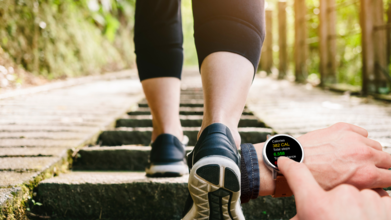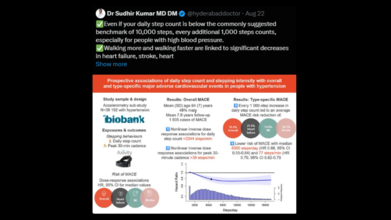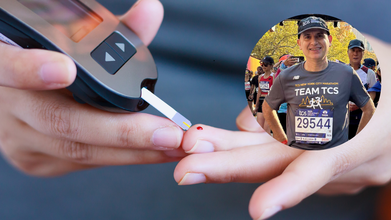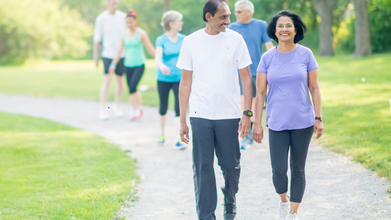- Health Conditions A-Z
- Health & Wellness
- Nutrition
- Fitness
- Health News
- Ayurveda
- Videos
- Medicine A-Z
- Parenting
No Longer Need 10,000 Steps? 2,500-4,000 Are Enough To Protect Your Heart, Says Doctor

Credits: Canva
For years, 10,000 steps a day has been seen as the gold standard for fitness. However, new medical perspectives suggest that walking fewer steps, if done correctly, can still provide significant health benefits. Hyderabad-based neurologist from Apollo Hospital, Dr. Sudhir Kumar, in a detailed post on X, explained why people should not feel discouraged if they fall short of the 10,000-step benchmark.
Rethinking the 10,000-Step Target
The 10,000-step goal originated decades ago as a marketing concept rather than a scientifically backed number. While it remains a popular target, experts now stress that the quality of walking matters as much as quantity. Walking at a brisk pace and steadily increasing one’s step count over time can greatly benefit cardiovascular health, especially for individuals with high blood pressure.
Dr. Kumar noted that the UK Biobank study, a large-scale health database, revealed how every additional 1,000 steps per day lowers the risk of heart-related conditions. Missing the 10,000 mark, therefore, does not negate the benefits of walking.
Evidence From the UK Biobank Study

According to the data, each 1,000-step increase in daily activity contributed to:
- A 17% reduction in major cardiovascular events
- A 22% lower risk of heart failure
- A 9% decrease in heart attacks
- A 24% reduction in strokes
These findings underscore that even modest increases in walking can create measurable differences in long-term health outcomes.
Brisk Walking Packs an Extra Punch
One of the most striking observations was that brisk walking during the most energetic 30 minutes of the day offered unique benefits, regardless of the total daily step count. Short bursts of faster-paced walking appeared to provide added protection against heart disease. This suggests that people who cannot reach higher step counts may still safeguard their health by incorporating short, brisk walks into their routines.
When we asked Dr Nagamalesh U M, Lead Consultant, Cardiology & Interventional Cardiology, Aster CMI Hospital, Bangalore, he said: "People who take fewer steps still reduce their risk of heart disease compared to those who hardly move at all. More steps bring more benefits. But the message here is encouraging: you don’t have to hit 10,000 to start seeing results. A short walk after meals, using stairs instead of elevators, or even walking while talking on the phone adds up. Small, steady steps can build a healthier heart without feeling overwhelming."
Lower Threshold, Higher Impact
Dr. Kumar emphasized that as few as 2,500 to 4,000 steps per day can significantly lower illness risk when compared with a sedentary lifestyle. This is especially encouraging for individuals who may struggle to achieve higher numbers due to age, chronic illness, or busy schedules.
He also pointed out that 1.3 billion adults worldwide live with hypertension, making walking an especially important and accessible form of preventive healthcare. Even small increases in activity, such as adding 1,000 steps daily, can meaningfully reduce complications associated with high blood pressure.
Dr Nagamalesh also pointed out that the bigger concern is not just the step count but avoiding a sedentary lifestyle. Sitting for long hours makes the heart and muscles less active, which can lead to stiffness in blood vessels, higher blood pressure, and increased risk of heart problems. Regular movement, even in smaller amounts, keeps the heart working smoothly. "When you walk, stretch, or stand up often, blood flows better, oxygen reaches your organs, and the heart doesn’t have to strain as much," he said.
How to Start Building Healthy Habits
For those looking to improve their step counts, experts recommend a gradual approach. Increasing daily activity by 500 to 1,000 steps at a time helps individuals avoid burnout and makes it easier to sustain the habit long-term. Maintaining a brisk pace is equally important, as intensity plays a key role in cardiovascular benefits.
This what Dr Nagamalesh suggested, "For people who sit at desks all day, the goal should not be chasing big numbers but adding movement into daily routines. Even if you can’t hit 10,000 steps, small changes can protect your heart and overall health."
- Take short breaks every hour like standing, stretching, or walking to refill your water. Use the stairs instead of the lift or walk to a colleague’s desk instead of sending a message.
- A quick 5–10-minute walk after meals can also improve digestion and circulation. If you’re on long calls, try standing or walking around while talking.
- At home, simple activities like light housework, gardening, or playing with kids all count as movement.
"The idea is not perfection but consistency. These small, regular efforts break long sitting hours and keep your body active. Over time, they add up to better heart health, without the pressure of chasing high step counts," he said.
A Simple and Accessible Strategy
Walking requires no special equipment, gym memberships, or training, making it one of the most accessible strategies for improving heart health. Dr. Kumar concluded in his X post that people should focus less on obsessing over 10,000 steps and more on moving consistently, briskly, and progressively.
Ultimately, whether someone walks 3,000 or 9,000 steps, the key message is clear: every step counts toward better heart health.
Run To Heal: How A 56-year-old NYC Teacher Ran To Reverse His Diabetes

Credits: iStock, PEOPLE
A New York City teacher Pedro Soto, 56, who teachers at the Manhattan school had a simple sore throat and he believed it was from a viral infection, but it soon turned out to be type 2 diabetes.
This was in April 2024, when he went to his doctor with the complaint of a sore throat and took a blood test. This is when he was "officially diagnosed with type 2 diabetes".
In an interview with PEOPLE, he tells while the doctor recommended medications for him, he was determined to make a lifestyle change first. "After receiving the news, I chose not to start medication right away. Instead, I committed to exercising, running twice a week and improving my diet."
Turns out, running, changed his life.
Running With Diabetes: Soto's Determination To Change His Life(style)
Pedro Soto first considered running the TCS NYC Marathon after a colleague mentioned that her husband had completed it. Motivated, he applied through a special program for teachers, sharing an essay about his type 2 diabetes diagnosis. His story earned him a spot on the team. As he trained, he closely monitored his health, undergoing regular blood tests every three months. The improvement surprised him. His blood sugar levels, once concerning, gradually returned to the normal range. While type 2 diabetes cannot be fully cured, it can be reversed, and Soto was seeing that transformation firsthand.
Training Through The Tough Times
The marathon was scheduled for November 2, 2025. Soto’s training, however, didn’t begin smoothly. In June, he learned he had Lyme disease. Around the same time, he lost his father. Because of these back-to-back challenges, he wasn't able to train consistently until August. Running soon became more than exercise. It became a way to navigate grief and rebuild strength.
He describes those months as emotionally heavy. Running offered him space to reflect, heal, and feel close to his father. It became a ritual that allowed him to confront his feelings rather than avoid them.
Experiencing the Race
To prepare mentally, Soto dove into YouTube videos and articles about the marathon. Still, nothing compared to the real thing. To him, race day felt like a citywide block party. The cheering crowds, music, and energy made the pain more bearable. He said that although the long hours of pounding take a toll on joints and muscles, the city's encouragement kept pushing him forward.
Finding Strength in His Students
The toughest stretch came in the final six miles, when self-doubt crept in. What kept him going was thinking about his students. Soto works with teenagers in a transfer program, many of whom have struggled in traditional school systems. Their perseverance inspired him. If his students could show up every day despite their challenges, he believed he could finish the race.
He says he is taking care of his health and this itself is an act of commitment to his students. Whenever he feels healthier, he shows up as a strong educator and for him the marathon teaches him the importance one needs in life of balance, self-care, and knowing when to put themselves first.
How Post Malone Lost 55lbs Just By Cutting Soda And Ditching Junk

Credits: Canva
"I'm excited for this next chapter in my life, I'm the happiest I've ever been, and for since I could remember I was sad," said Post Malone as he talked about his journey of losing 55 pounds. He went from 240 lbs to 185 lbs, he revealed at The Joe Rogan Experience Podcast. His inspiration? His daughter. He said that he is focused more on his health since becoming a father.
"It is definitely made me take better care of myself. I want to be around to see her go and do kick-*ss stuff. And before, you know, I was really drinking a lot and smoking a lot and stuff. I kind of took everything and toned it down a little bit and, you know, doing my best and really got my weight going," he said.
His weight loss journey started after he welcomed his daughter in May 2022, and on April 20233, he shared on his Instagram that post becoming a father he is now prioritizing his health.
How Did Post Malone Lose So Much Weight?
He said it is simple, he decided to "kick soda and start eating better". He also is trying to cut down his smokes and brews or give up completely, which is taking time.
On his Instagram post, he wrote: "I've had a lot of people ask me about my weight loss and I'd suppose, performance on stage. I'm having a lot of fun performing, and have never felt healthier. I guess dad life kicked in and I decided to kick soda and start eating better so I can be around for a long time for this little angel. Next up is smokes and brews, but I like to consider myself a patient man... lol!"
While his fans were initially concerned about his weight loss, he reassured them that his "brain is in a super dope place" and he was "the happiest" he has ever been in a long time.
When he made his appearance in June 2024, on The Joe Rogan Experience Podcast, he said that his fans in fact, thought, that he started using drugs, due to his drastic weight loss. This is why he posted on Instagram to deny those allegations. “I remember, whenever I started losing my weight, everybody was like, ‘Hey, this is what meth looks like,’ and I started dancing on stage and having fun and having more energy and just enjoying life again, you know what I mean,” he told host Joe Rogan. “Like I mentioned, I was s***** for a long time, but I had my baby and I’m in a great f****** spot and then the first thing that happens is like, ‘Oh he’s on f****** drugs.’"
However, Malone has confirmed that he is not "any hard drugs".
What Helped Malone Lose 55 Pounds?
In an appearance on The Howard Stern Show in October 2023, Malone said that he has not been on weight loss medication, rather he is now making better food choices.
Earlier, whenever he was on tour, he would go for junk, but now, he has made a deliberate choice to eat "grilled chicken" "carrots" with a "little bit of white rice with hot sauce". He said he was blown away to find out that hot sauce has no calories.
He also shared that he has cut out fried food and pizza. He shared that he would previously eat a lot of junk while on tour, especially because those places were open at 2 am after a show. However, when he made those small dietary changes, he lost 20 pounds, which made him think "let's keep building".
He also shared that he started cutting down on his soda intake. However, he would occasionally reward himself with one after a show.
He also showed off his weight loss in an August 2023 Instagram post on a mirror selfie and wrote: "Introducing Viceroy Chungus VonBattlepass, i love you," in caption.
Cannot Hit 10,000 Steps A Day? A Short Stroll Too Could Make You Healthy

Credits: Canva
For years, the idea of walking 10,000 steps a day has been treated like universal fitness wisdom, however, a recent study reveals that even a short stroll too could help you stay healthy.
From fitness trackers to morning-walk groups, the number has been repeated so often that many people believe it is a scientifically proven rule. The truth is far simpler and far more encouraging. New research shows that you do not need anywhere near 10,000 steps to improve your health. In fact, even a small amount of regular movement can dramatically lower your risk of heart disease and early death.
What Recent Research Reveals
A new study published in the British Journal of Sports Medicine examined how step counts influence longevity and heart health, particularly in older adults. The findings were surprisingly optimistic. Scientists discovered that walking as few as 4,000 steps in a day, even if you manage this number only one or two days a week, can reduce the risk of death by 26 percent. It can also lower the risk of heart disease by 27 percent when compared to those who barely moved.
The benefits became even more striking when participants achieved the 4,000 step target on more than three days per week. In that group, mortality dropped by more than 40 percent and the risk of heart issues fell by 27 percent. These numbers show that moderate, regular walking has powerful protective effects on long-term health.
How Many Steps Do You Really Need
The study also explored whether aiming for higher step counts brings additional benefits. Researchers found that walking around 7,000 steps a day provides a slight extra advantage when it comes to living longer. However, it does not significantly change cardiovascular outcomes. This means that hitting 4,000 steps is already enough for meaningful protection, especially for older adults or people who are unable to reach higher counts.
Interestingly, the study also revealed that the number of days you walk matters far less than the total steps collected throughout the day. When scientists adjusted for total daily steps, the link between how many days people walked and their health results disappeared. The real takeaway is this: what matters most is how much you move overall, not whether you meet a daily or weekly quota.
Why Consistency Matters More Than Intensity
Walking is one of the simplest forms of movement, yet its benefits are remarkably wide-ranging. It is gentle, low impact and accessible to almost everyone. Regular brisk walking has been shown to improve heart health, support weight management, boost mental well-being and improve mobility. These improvements occur because consistency helps the body adapt, even when the total effort seems small.
For older adults, or for anyone returning to activity after a long pause, this consistency is especially important. Small, steady efforts accumulate and gradually build up stamina. Over time, this reduces the risk of chronic disease and enhances overall fitness without stressing the joints.
Tips To Make Walking A Sustainable Habit
If you want to enjoy the health benefits of walking, the key is to stay consistent rather than chase big numbers. A few practical tips can help you build a routine that feels realistic and enjoyable.
Start slowly
If you have been inactive for a while, begin with five to ten minutes of walking at a comfortable pace. Gradually increase your duration and distance over several weeks. This prevents strain and reduces the risk of giving up too soon.
Set achievable goals
Aim for manageable targets such as walking 20 to 40 minutes three days a week. Once this feels comfortable, you can add more time or increase your frequency if you wish.
Adjust your routine when life gets busy
If you are traveling or have long work hours, try breaking your walks into shorter chunks. A few five to ten minute walks throughout the day can help you stay on track.
Do not let the weather stop you
When outdoor conditions are not ideal, choose indoor spaces such as malls, gyms, community centers or even long corridors at home or work.
Add variety to your routes
Different routes help fight monotony and make walking more enjoyable. Rotate between parks, neighborhoods or indoor spaces to keep things fresh.
© 2024 Bennett, Coleman & Company Limited

